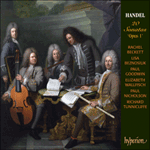This sonata seems to have started life for the oboe but, elevated from F to G, it fits the flute very happily. After an Adagio, brief but expansive of line, Handel embarks on a fugue; this time the bass comes in four bars on with a genuine fugal answer. But Handel doesn’t keep it up for long, running off into episodes with flute passagework, then with the continuo instruments scrubbing away while the flute persists with the main theme, and finally with much free interchange between the two—altogether a strongly shaped movement. Then comes an Adagio, with what promises to be a ground bass; but Handel rarely uses forms rigidly and soon he lets the bass pattern become absorbed into the texture of the music as a whole. Two dances follow, a bourrée (or borée) and a minuet, the latter on a favourite Handel theme.
from notes by Stanley Sadie © 2001
Cette sonate semble avoir été écrite pour hautbois au départ mais, transposée de
fa en
sol, elle convient à merveille à la flûte. Après un Adagio bref mais mélodiquement expansif, Haendel entame une fugue; cette fois, la basse se présente sous forme de quatre mesures suivies d’une authentique réponse fuguée. Mais Haendel ne maintient pas longtemps ce type d’écriture, s’échappant dans des épisodes de virtuosité à la flûte, puis d’autres où le continuo s’active tandis que la flûte persiste avec le thème principal, et finalement dans de nombreux échanges libres entre continuo et flûte: au total, un mouvement fortement charpenté. Puis vient un Adagio, don’t la basse semble vouloir être une
ground bass; mais Haendel utilise rarement les formes de manière rigide et le motif de la basse a tôt fait d’être absorbé par la texture d’ensemble de ce mouvement. Lui succèdent deux danses, une bourrée (ou borée) et un menuet, ce dernier sur un des thèmes favoris de Haendel.
extrait des notes rédigées par Stanley Sadie ©
Français: Josée Bégaud
Diese Sonate scheint ihr Dasein als Werk für Oboe begonnen zu haben, doch eignet sie sich, von F nach G hinauftransponiert, ausgezeichnet für die Flöte. Nach einem kurzen, aber melodisch expansiven Adagio setzt Händel zu einer Fuge an; diesmal setzt der Baß vier Takte später mit einer echten fugalen Entgegnung ein. Aber Händel hält das nicht lange durch, sondern entflieht in Episoden mit Passagenwerk für die Flöte, woraufhin die Continuo-Instrumente fleißig vor sich hin schrubben, während die Flöte am Hauptthema festhält; schließlich entsteht viel freies Wechselspiel zwischen beiden—insgesamt ein überzeugend gefügter Satz. Danach setzt ein Adagio ein, dessen Baß zum Ostinato zu werden verspricht; doch Händel nutzt Formen selten rigide, und bald läßt er das Baßschema in der Gesamttextur der Musik aufgehen. Zwei Tänze schließen sich an, eine Bourrée und ein Menuett, letzteres über eines von Händels Lieblingsthemen.
aus dem Begleittext von Stanley Sadie © 2001
Deutsch: Anne Steeb/Bernd Müller


 Handel: 20 Sonatas Op 1
Handel: 20 Sonatas Op 1
